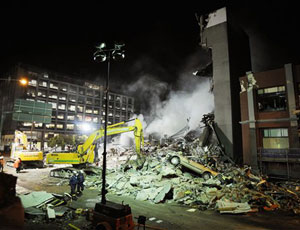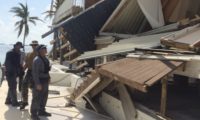The New Zealand earthquake surprised engineers by triggering severe damage or collapse of some recently constructed buildings.

The magnitude 6.3 earthquake that struck 10 km from Christchurch, South Island, New Zealand on Feb. 22 brought down or severely damaged some contemporary structures because the quake was extremely shallow—centered only 5 km below the surface.
“New Zealand has very good loading standards and a strict regulatory environment and since the mid-70s onwards, the buildings have been designed for earthquake resistance very well,” says John Wilson, chair of the Australian Earthquake Loading Standard and Deputy Dean of Engineering at Swinburne University of Technology, speaking on behalf of the Australian Science Media Centre (AusSMC).
The standard of design has been improving over the last 20 years or so, “which is why most buildings performed well, with the exception of a few buildings that were severely damaged or partially collapsed.”
Engineers representing the international community are already gearing up to inspect the damaged contemporary buildings to determine why they failed.
A team from Miyamoto International Inc., led by Amir Gilani, left for New Zeland Feb. 23. There the team will meet up with a New Zealand civil engineer. A team from Canada plans to go to Christchurch soon.
“The New Zealand construction code is one of the most stringent in the world for new buildings and it partially inspired our own Canadian Code,” says Dr René Tinawi, manager of the Canadian Seismic Research Network and Professor Emeritus at the Ecole Polytechnique de Montreal.
“This is why Canadian experts would like to inspect first-hand how newer buildings fared during this second Christchurch earthquake, as soon as the situation allows.”
To help with rescue and recovery, and at the request of the New Zealand government, the U.S. is deploying a U.S. Agency for International Development (USAID) Disaster Assistance Response Team (DART). The team will include the Los Angeles County Fire Dept.�S Urban Search and Rescue team (USAR) to assist with the search and rescue efforts.
The USAR component of the DART will be what is called a "heavy team," bringing more than 70 specialized personnel and all necessary equipment to make live rescues in even the most precarious situations, according to USAID.
Engineers are not surprised there is damage, especially to the older, unreinforced masonry buildings, considering their masonry is heavy, brittle and vulnerable to earthquake shaking.
“This quake was pretty much a bullseye � it was quite a large Magnitude 6.3 event and so close to Christchurch that we weren�t surprised to see significant damage; at that close range, the level of shaking is quite severe,” says Wilson.
The New Zealand Building Code can be viewed on-line. In particular, clause B1-Structure covers seismic resistance, says the AusSMC. The loading code from 1976 to 2004 was in various editions of NZS 4203, and since then NZS 1170.5.
Limit state design methods have supplanted working stress methods for habitable buildings during this period. All of the loading codes define seismic hazard zones on maps that have changed over the years.
Apart from the zone factor, the designer must include soil type, building natural period, importance level, and working life in determining the earthquake loads to be used in design.
An Aftershock of Earlier Quake
"New Zealand is a first-world country, and the reason the damage is so much greater is that it's an aftershock of the larger 7.1 magnitude earthquake that happened last September near Christchurch,” says Melissa Giovanni, a professor of geology at the University of Calgary, Alberta, Canada.
Giovanni speculates that buildings were already weakened by the Sept. 4 quake so much that magnitude 6.3 temblor would be much more devastating.
“Another reason this earthquake was more damaging is that it was closer to the surface, and so the movement would be more intense than in a deeper quake where the earth can dissipate some of the energy,” says Giovanni.
In New Zealand, the North Island is located where two plates are converging - the Australian Plate and the Pacific Plate. On the South Island, the plates are sliding past each other in what is called a strike-slip fault, called the Alpine Fault. It's similar to the San Andreas Fault in California, says Giovanni.
"These plates are always in motion,” she adds.
The plates grinding and scraping past each other breaks rocks and causes earthquakes.
The crust is still trying to regain its equilibrium since the Sept. 4 quake, says Giovanni.
She calls the fault that broke an oblique thrust, which means there was some horizontal movement and some vertical movement.
“So the initial movement probably felt like a lift as the earth moved vertically, and then later you would feel vertical and horizontal movement," says Giovanni.
The Feb. 23 quake is part of a series of aftershocks from the September event, say engineers. Aftershocks have been common since September, with several reaching magnitudes larger than 5.0.
“We can expect aftershocks to continue for days, weeks, and months,” says Giovanni.
.



Post a comment to this article
Report Abusive Comment